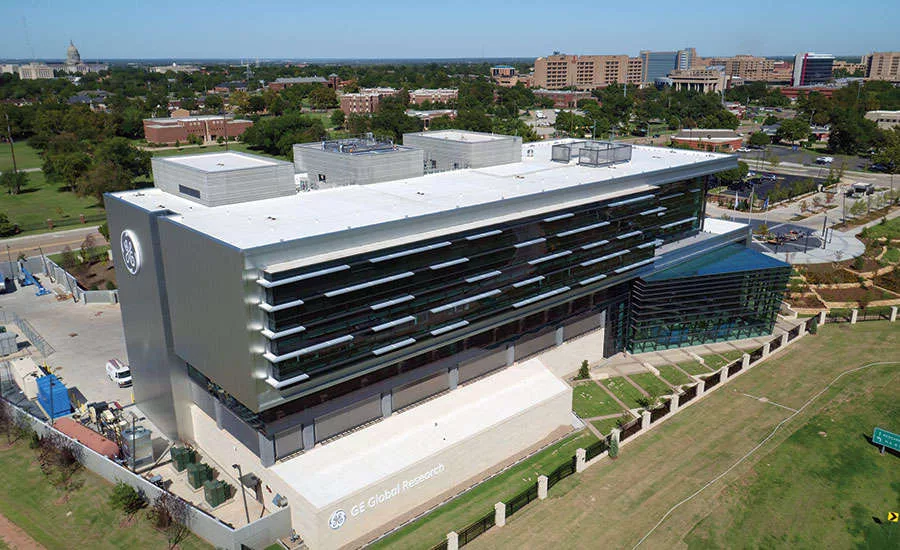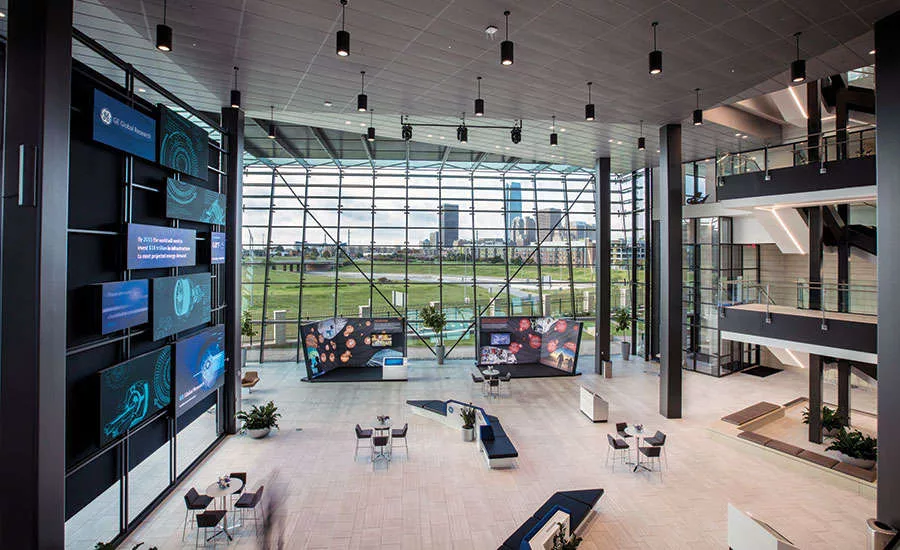Securing Innovation, the GE Way
GE’s new Oil & Gas Technology Center is a balanced mixture of high-end security technology and a strong customer focus.

Keeping past security and terrorism related events within the U.S. and worldwide in mind, GE’s Enterprise Security team was hands on during the planning and construction phase of the OGTC, including GE Global Research's Global Security Director, Elizabeth Gildea, who brought on Bill Muller (pictured), a former Special Agent with the U.S. Secret Service, to implement and manage the security plans as the OGTC's Security Manager. Photo courtesy of GE

The OGTC sits on 8.75 acres and is completely enclosed with a perimeter fence with access gained by one of two entry points. Access to the site is granted by employee badge, access list or the visitor management system. Photo courtesy of GE

GE’s new Oil & Gas Technology Center in Oklahoma City will become a central hub for GE scientists and engineers to closely collaborate with the Oil & Gas industry on cutting-edge digital and hardware solutions to advance the industry. Photo courtesy of GE
In April 1995, Timothy McVeigh and Terry Nichols bombed the Alfred P. Murrah Federal Building in downtown Oklahoma City, Oklahoma. The terrorist attack destroyed one-third of the building, killed 168 people and injured more than 680. The blast destroyed or damaged 324 other buildings within a 16-block radius, shattered glass in 258 nearby buildings and destroyed or burned 86 cars, causing more than $650 million worth of damage.
Rescue efforts were undertaken by local, state, federal and worldwide agencies. The Federal Emergency Management Agency (FEMA) activated 11 of its Urban Search and Rescue Task Forces, consisting of 665 rescue workers, who assisted in rescue and recovery operations.
It was the deadliest terrorist attack on American soil until the September 11 attacks six years later, and it still remains as the deadliest domestic terrorism incident in U.S. history.
The official investigation, known as “OKBOMB,” saw FBI agents conduct 28,000 interviews, and collect more than three tons of evidence and one billion pieces of information.
As a result of the bombing, the U.S. Congress passed the Antiterrorism and Effective Death Penalty Act of 1996, which created legislation designed to increase the protection around federal buildings to deter future terrorist attacks.
The bombing changed the state of Oklahoma and the country as a whole forever, but it didn’t stop businesses and families from calling it home, including GE’s new Oil & Gas Technology Center (OGTC), in Oklahoma City, which is a central hub for GE scientists and engineers to collaborate with the oil and gas industry on digital and hardware solutions. It officially opened in October 2016, and it is a shining example of high-tech security with GE’s historically customer-centered beliefs and strategy.
The OGTC
The OGTC is five stories, with 125,000 square feet of lab and office space that includes 400-foot and 60-foot deep test wells, two 30-ton overhead cranes for moving large testing equipment and an entire floor dedicated to customer collaboration with embassy offices. It can accommodate almost 230 people, and it has established several programs and partnerships with industry and academia, including Oklahoma State University and the University of Oklahoma and has R&D agreements in place with many of the leading operators in North America.
The oil and gas industry is suffering one of its worst slumps ever, with recovery slow to take hold and unlikely to deliver any time soon the higher prices producers enjoyed a few years ago. However, according to an article in USA Today (October 5, 2016), the OGTC might be what the oil and gas industry needs to break out of that slump, as the center is home to scientists and technicians that can simulate conditions in wells and collaborate with customers on new means of probing and producing from oil and gas formations. “They will find advances in software, sensors and other digital applications, that are considered key to long-term recovery in the oil and gas patch,” the USA Today article said, essentially, writing a new chapter for the U.S. oil and gas industry.
GE’s nine other global research centers focus on a variety of industries, but the Oklahoma City center is the first to specialize in one area. Unconventional oil and gas drilling is taking place in other parts of the world, so there is an opportunity to bring those professionals to Oklahoma City to study and learn with others in the industry. GE executives hope the OGTC will provide the ability for commercialization of new technology and a new approach at a faster pace.
While the Oklahoma City facility will focus only on the oil and gas industry, it still will have access to the GE Store, which is the company’s term for technology that has applications across multiple industries. For example, GE is using technology developed to protect jet engines from sandstorms to help make unconventional oil and natural gas drilling more efficient.
In addition to the excitement generated about the technology, engineering and high-level scientists within the OGTC is the fact that it has some of the newest and state-of-the-art access control, security video and guard force to provide a safe work environment for the employees, visitors and contractors.
Keeping past security and terrorism related events within the U.S. and worldwide in mind, GE’s Enterprise Security team was hands on during the planning and construction phase of the OGTC, including Elizabeth Gildea, Global Security Director at General Electric Global Research (GEGR), who brought on Bill Muller, a former Special Agent with the U.S. Secret Service, to implement and manage the security plans as the OGTC's Security Manager. Muller’s experience also includes conducting dozens of protective advances in both domestic and international settings for the U.S. President, Vice President and visiting foreign heads of state. This led to developing skills in diplomacy, negotiations and in dealing with high-level government and corporate leaders.
The OGTC sits on 8.75 acres and is completely enclosed with a perimeter fence with access gained by one of two entry points. Access to the site is granted by employee badge, access list or the visitor management system.
The integration for the site was completed by Convergint Technologies, and is one the first sites within GE to use the Lenel OnGuard platform for access control.
The access control security management system at OGTC was designed to meet the GE security requirements to ensure complete system security, resiliency and reliability. Throughout the campus, multiple access controlled points manage and supervise door access and functionality, while maintaining integrity to areas with restricted access. Access-controlled entrance and egress lanes and turnstiles are in use on the site.
Visitors to the OGTC are welcomed at the main entrance and receive a badge identifying them, their level of access and who their host for the visit. The system also assists in case of an emergency, as security staff can quickly identify the number of personnel on the site.
The OGTC’s surveillance system includes PTZ cameras from Axis Communications and Genetec Security Systems. PTZ dome network cameras and fixed cameras monitor all traffic on the OGTC campus, to include all doors and exits, including the entire perimeter.
With so many access control and visitor management technologies, OGTC’s security team needed the ability for centralized command and control. A Security Operations Center (SOC) is the heartbeat of the OGTC site security department. The SOC is an around-the-clock building management system support function for security and facility services – in which all emergencies and day-to-day incidents are serviced through. It is a secure location to protect the proprietary systems. It provides customer service to all employees, visitors, contractors and vendors as needed to facilitate the site to OGTC standards. It is the goal for the SOC to provide both the GEGR-OGTC employees and associates with a precision response to all calls for assistance.
The OGTC campus has more than 16 miles of fiber and 44 miles of copper for cabling infrastructure that links all network and access control devices to the SOC and the OGTC. Within the SOC, OGTC security personnel can monitor, secure and respond to all of its operations. The Onguard Lenel and other control systems interface to support all equipment and monitoring for both traditional security and life safety/operations systems. Access controlled doors, interior and exterior security cameras, gate intercoms/cameras, and duress buttons are all accessible and controlled from the SOC.
In the event of a security incident at the campus, SOC operators can see and remotely adjust PTZ cameras to assess site conditions, unlock all access-controlled doors to allow employees out of the facility or first responders into the facility, and then monitor the mustering of each employee to a safe zone via card reads. SOC operators can then notify on-site security personnel of any employees which are not at the muster site, relay their latest badge-in location and begin to look for them on video, or dispatch personnel to their last known location.
Muller says, “We have a clear EHS mission that we call ‘I AM,’ meaning we are focused on empowering all employees with the personal responsibility to be committed to integrity, quality and EHS in all of their activities – at our site or a customer’s site.”
In addition to Muller, OGTC’s Security and Compliance Specialist Wavelon Jackson works directly with the security officer team from G4S, which Muller speaks very highly of, particularly during the construction phase of the OGTC.
The G4S team ensures compliance with employee and visitor access control policy and procedures as set forth by the OGTC requirements, conducts foot patrol rounds, monitors ID card access and control and the employee database, and responds to emergency situations and more.
“Last year, when the building was far from the jewel it is today, the majority of the G4S team signed up to work at essentially a construction site,” Muller explains. “The guards were housed out of a trailer and had a binder to document the events and duties of their shift. A flip phone was issued to be used by the on duty guard. The building was filled with dry wall dust, paint and construction debris. The site had mud and other hazards everywhere for the guards to navigate. And none of the G4S team quit or left for another job. In fact, we had security officers from other G4S facilities requesting to work here. We have an outstanding contract and partnership with G4S. They have stayed here and have embraced GE beliefs and the GE way of doing things.”
Muller shares, “We had to have a system where our stakeholders and visitors were comfortable with the technology solutions that were implemented for visiting the site. Notwithstanding the challenges of blending security products with the aesthetic direction of OGTC’s interior and exterior design structure, steps were taken to ensure the security hardware blended with the flow and design of the campus, and strategic placement of devices did not compromise the integrity of the security design.”
A Good Neighbor
While Muller and his team were given the opportunity implement a very high level of security technology into securing the OGTC facility and its surroundings, he stresses that the enterprise security team keep the customer first, following the GE corporate message.
Required employee training helps to facilitate the customer first message, Muller shares, to reinforce the commitment to keeping all visitors and employees safe while allowing them the required freedom to do their jobs.
“Different GE locations have different demands and needs and security strategies and operations. But having a consistency to security training that’s required by every employee helps me and my team to facilitate the customer’s needs while also doing our jobs to the best of our abilities.”
Looking for a reprint of this article?
From high-res PDFs to custom plaques, order your copy today!





